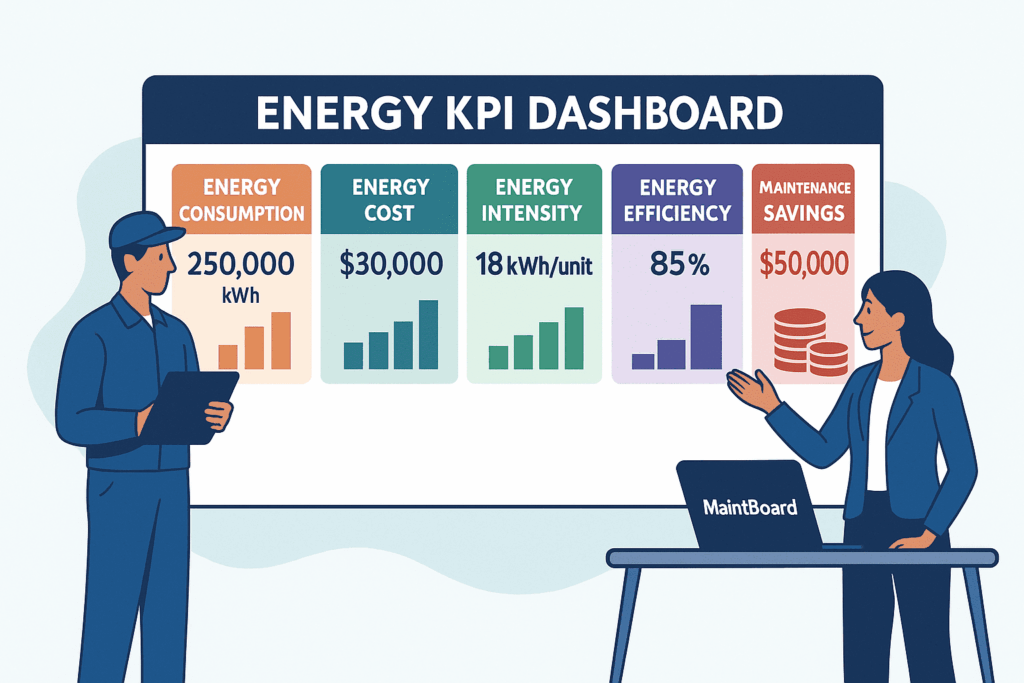Energy KPI Maintenance: 7 Metrics Every Maintenance Manager Should Track

Introduction
Maintenance isn’t just about fixing breakdowns anymore—it’s about driving efficiency across people, processes, and power. As energy prices rise and sustainability becomes a board-level concern, maintenance managers are expected to track more than just downtime.
Enter energy KPI maintenance: a strategic approach that uses energy data to improve asset reliability, reduce utility costs, and extend equipment life.
In this article, we’ll explore the top 7 energy KPIs that every maintenance leader should monitor in 2025 and beyond.
1. Energy Consumption per Asset (kWh/Asset)
This KPI helps you understand which equipment consumes the most energy relative to its function. It enables:
- Prioritization of high-impact assets for upgrades or PMs
- Detection of abnormal usage patterns
- Benchmarking across similar assets
Formula:
Total Energy Consumed by Asset (kWh) / Time Period
Example:
If a compressor consumes 1,200 kWh in a month → KPI = 1,200 kWh/month
Why It Matters:
Helps identify energy-hungry assets and detect performance issues early.
2. Energy Cost per Work Order
This KPI links energy use to maintenance tasks, giving you a more accurate cost per job.
- Helps evaluate if repairs are energy-efficient
- Supports budget forecasting
- Promotes energy-conscious maintenance planning
Formula:
(Energy Consumed during Maintenance Task × Cost per kWh)
Example:
A motor service used 40 kWh at ₹7 per kWh → KPI = ₹280/work order
Why It Matters:
Accurately tracks true cost of maintenance and helps justify proactive strategies.
3. Idle Energy Consumption
This KPI measures wasted energy from equipment running unnecessarily. It’s especially useful for:
- Pumps, conveyors, and HVAC systems
- Shifts with low production
- Identifying automation gaps
Formula:
Energy Used While Not Operating (kWh) / Total Idle Hours
Example:
Pump left running 8 hours daily when idle → 8h × 5 kW = 40 kWh/day
Why It Matters:
Highlights waste from poor shutdowns and unoptimized standby systems.
4. Energy Efficiency Ratio (Output per kWh)
This metric tells you how productive your energy use is. It’s particularly helpful for:
- Measuring equipment wear or imbalance
- Monitoring changes post-maintenance
- Improving throughput per energy unit
Formula:
Units of Production / Total Energy Consumed
Example:
1,000 units produced using 500 kWh → KPI = 2 units/kWh
Why It Matters:
Correlates directly to productivity. A lower ratio often signals equipment wear.
5. Energy Loss Due to Downtime
Even when not producing, many machines still draw power. This KPI helps maintenance teams quantify that loss:
- Supports downtime root-cause analysis
- Highlights cost of delayed repairs
- Promotes targeted PM scheduling
Formula:
Energy Consumed During Downtime (kWh) × Cost per kWh
Example:
25 kWh used during unexpected halt × ₹10 = ₹250 lost energy
Why It Matters:
Quantifies energy waste from unplanned events and supports failure prevention.
6. Carbon Emissions per Asset
For sustainability-conscious plants, this KPI links energy use to environmental performance. It supports:
- ESG and Scope 2 emissions reporting
- Prioritization of carbon-heavy assets for upgrades
- Regulatory compliance efforts
Formula:
Energy Used (kWh) × Emission Factor (kg CO₂/kWh)
Example:
800 kWh × 0.82 kg CO₂/kWh → KPI = 656 kg CO₂
Why It Matters:
Links maintenance impact to ESG goals and Scope 2 compliance.
7. Percentage of Energy-Triggered Work Orders
This KPI reflects how much your maintenance is driven by energy intelligence. Use it to:
- Track adoption of predictive maintenance
- Justify further investments in metering
- Evaluate effectiveness of energy alert settings
Formula:
(Number of Energy-Based Work Orders / Total Work Orders) × 100
Example:
10 out of 100 WOs were triggered by energy anomalies → KPI = 10%
Why It Matters:
Shows how effectively your team is using energy insights for predictive maintenance.
How to Track These KPIs in MaintBoard
MaintBoard CMMS supports energy KPI maintenance through:
- Energy meter integrations (Modbus, MQTT, OPC UA)
- Custom KPI dashboards for plant heads and engineers
- Alerts and reports based on consumption thresholds
- Work order tagging by energy triggers
These capabilities turn energy data into actionable maintenance strategies.
FAQ: Energy KPIs for Maintenance Teams
Can I track energy KPIs without integrating meters?
You can estimate, but true visibility comes from direct meter integration.
How often should I review these KPIs?
Monthly is recommended, but high-consumption assets may need weekly checks.
Do these metrics apply only to factories?
No. Hospitals, cold storage, and data centers can benefit just as much.
What’s a good baseline for each asset?
Start with historical averages and adjust as you collect real-time data.
Conclusion: Measure What Matters
Energy KPI maintenance is no longer optional. As utility costs rise and ESG targets tighten, maintenance teams must take ownership of asset energy performance.
Start small—track 2–3 KPIs for your most critical assets. Then expand. The insight you gain will lead to smarter PMs, fewer surprises, and better bottom-line results.
Want to explore how MaintBoard makes energy KPI tracking effortless? Schedule a walkthrough or speak to our product team.
